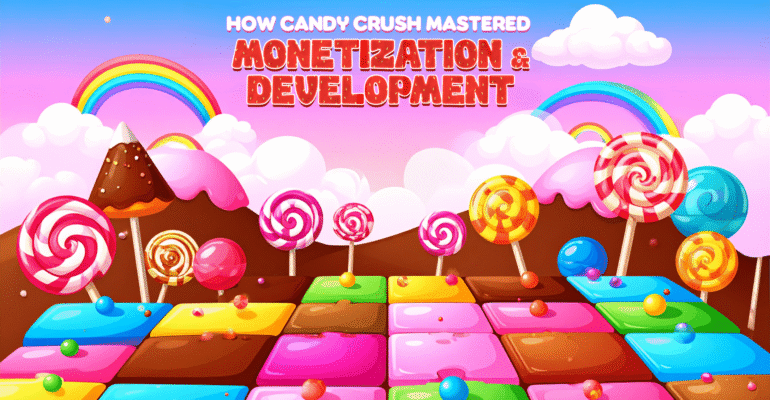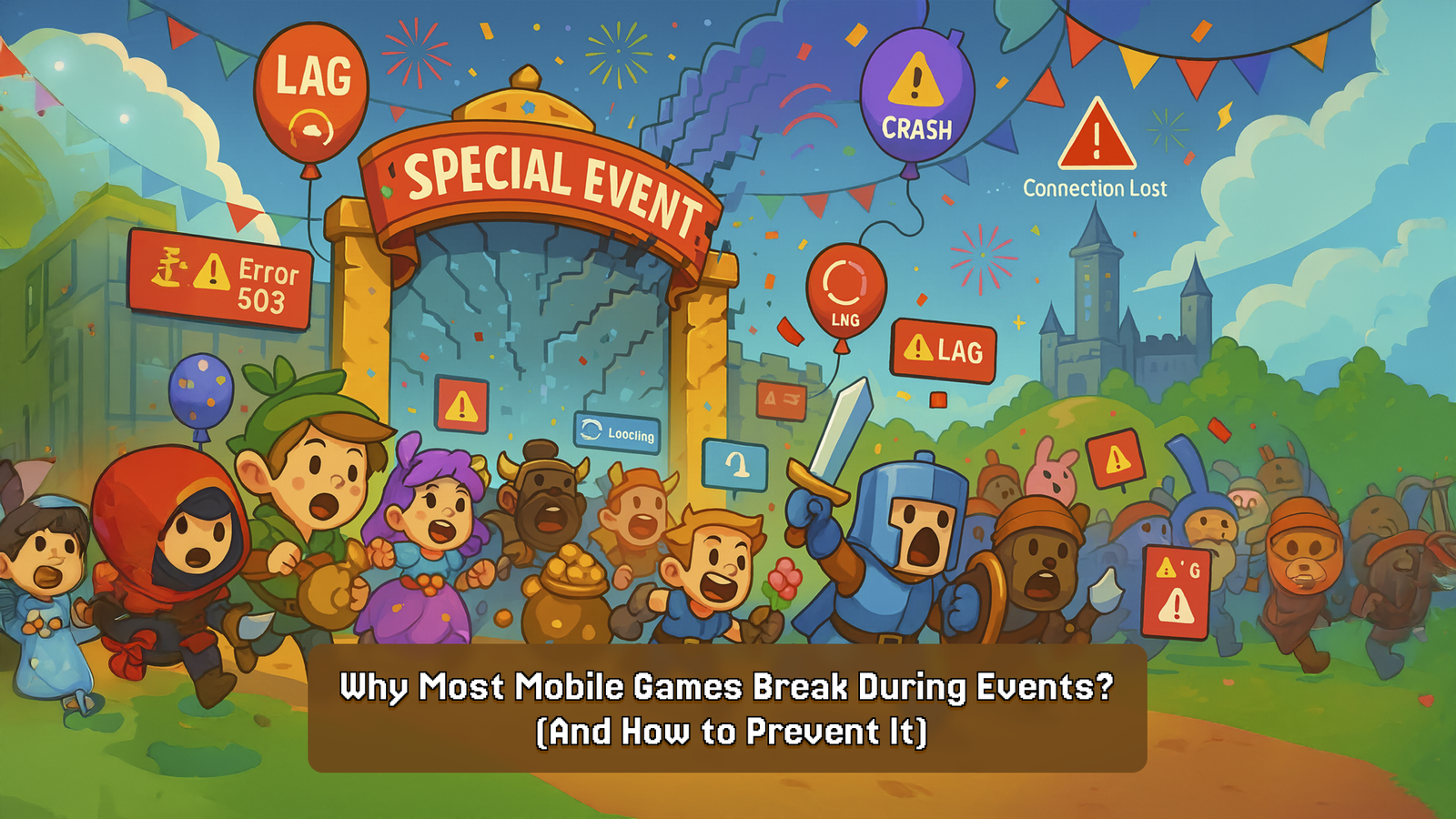How Candy Crush Mastered Game Development & Monetization
How Candy Crush Mastered Game Development & Monetization

Contents
In 2012, King launched Candy Crush, a game that changed the way mobile game development and monetization worked. With 3.5 billion downloads, 273 million monthly players, and $20 billion in lifetime revenue, Candy Crush shows how fun and profit can blend seamlessly.
These numbers prove how King turned a simple puzzle into a global success through smart game development and monetization. What started as a simple Match-3 puzzle has grown into a highly engaging game packed with new challenges. Why is it so hard to put down?
This blog explores how Candy Crush mastered game development and monetization, creating an experience that appeals to nearly all age groups. It also presents key insights on boosting monetization without reducing the fun.
Mastering Game Development
King’s approach to Candy Crush set a new benchmark for hyper-casual mobile games. It was carefully designed with the target audience in mind. Here is how Candy Crush set a gold standard for game development:
Vibrant Visuals That Spark Joy
Source: BlueStacks
Candy Crush is more than just visually appealing; it’s designed to spark delight. Bright colors, cheerful characters, and satisfying animations make every move rewarding. Each swipe is packed with effects and sounds that keep both kids and adults engaged. As a result, each match feels like a mini celebration, thanks to colorful bursts, fun jingles, and smooth transitions.
New Content with LiveOps
LiveOps (Live Operations) keeps mobile games like Candy Crush fresh by delivering real-time content updates. Weekly level drops, limited-time events, and seasonal themes ensure players always have something new to enjoy. AI tools help automate content, tweak mechanics, and keep players engaged.
Weekly levels, seasonal events, and holiday specials keep players hooked. This LiveOps strategy helped make Candy Crush game design a model for mobile gaming.
Source: King Community
King’s LiveOps strategy includes:
- Event management: These are timed challenges with exclusive rewards.
- Real-time updates: These are updates released regularly in themes like seasonal events, regional festivals, or pop culture integrations.
- Retention strategy: This includes bonuses, rewards, and offers for players who come back to the game.
User-Centric Design That Prioritizes Fun
Candy Crush puts fun first, monetization second. King prioritized entertainment, knowing that higher engagement naturally leads to better revenue. The result? A game players love to return to — and are happy to spend on.
The game uses AI to adjust difficulty levels based on player performance and feedback. King avoids interrupting gameplay with ads. Instead, ads appear later and only for players already invested in the game.
Evolving Gameplay
King understands that hype doesn’t last; it will eventually die out unless new content is constantly introduced. Candy Crush always updates the mechanics for its elements, such as blockers, candies, or puzzles.
Source: BlueStacks
Binge-Play Design
Levels are designed for quick sessions, perfect for a lunch break or commute. Cross-platform deployment helps the game fit into players’ daily routines. The “easy-then-tough” level pattern balances challenge and fun, preventing frustration or burnout. The light story, featuring quirky characters like Toffee, keeps players emotionally invested.
Social Mechanics
Source: annahesselbom
Candy Crush has made virality a crucial part of the gameplay. When King released the game on Facebook in 2012, it was built as a social experience. Players can send and receive lives, share boosters, and get push notifications about their friends’ progress.
The game also uses AI to analyze player behavior and fine-tune the gameplay. Together with competitive and cooperative modes, these elements drive social engagement and build player loyalty.
Leaderboards push players into friendly rivalry, keeping them competing without frustration. The callback system lets players send lives to friends. Seeing friends complete higher levels also draws players back into the game.
Mastering Monetization
King revolutionized the free-to-play model by using subtle money-making methods that feel rewarding, not limiting. Candy Crush encourages spending without forcing it, blending gameplay and monetization smoothly. Its success comes from blending fun with subtle opportunities to spend.
Let’s explore the Candy Crush monetization strategy that made it a billion-dollar hit:
Free-to-play Without Friction
Being a casual free-to-play game, anyone can play it without paying any upfront cost. So, whether a player is on a high-end device or a budget smartphone, a smooth and clean experience is assured.
Ads that Don’t Annoy
Source: King Community
In 2013, King removed all ads to give players a complete game experience. In 2018, King carefully reintroduced ads through a reward system. It was a bold move, as ad revenue was one of the key sources of cash flow. In 2018, King reintroduced ads as rewards – watch a short ad to earn a booster or free life. The decision to watch or skip the ad was still in the hands of the players – No interruptions, no forced views, a classic strategy indeed.
Personalized Offers that Make Sense
Candy Crush follows a personalized approach for offers based on players’ in-game behavior and purchase history. Through AI-driven game monetization, players get ads relevant to them. Players who have never spent money see low-entry offers, while regular spenders get bundle packs with upgrades.
Driving Spend Without Pushbacks
With its freemium game strategy, King ensures the game is available to all while smartly pushing players toward in-app purchases. Here are the best practices of mobile game monetization techniques used in Candy Crush:
- Life System: The game uses the dreaded Zynga life model, which caps the gameplay once all 5 lives are exhausted unless the player waits or pays for it. While it may sound harsh, it actually avoids burnout, increases session value, and nudges players to make purchases.
- Timed difficulty spikes: Difficulty spikes aren’t random. Candy Crush uses player data to find the best moments to nudge players toward spending a little on boosters.
- Consumable Power-Ups: Consumable items often make up most in-game purchases. Candy Crush sells bundles of three boosters – color bomb, striped candy, and coconut wheel; to help players beat tough levels.
- Charms: King introduced Charms to reduce game difficulty through permanent power-ups and priced them at a premium. Later, King phased out Charms to create a more balanced, free-to-play system. Recently, King teased a new “charming feature” on Instagram, hinting at a probable comeback.
Events that Align with the Theme
Candy Crush places ads strategically, instead of cluttering the game with banners. They only collaborate with brands, firms, and celebrities that fit the game’s narrative. For instance, King partnered with Nestlé to feature KitKat candies inside the game’s universe. Rather than traditional intrusive ads, King included KitKat elements in the game’s design, blending them naturally with the theme.
Source: minimeinsights
Conclusion: Lessons From an Empire of Candies
Understanding the Candy Crush business model is essential for achieving long-term success. Candy Crush proves that even a casual game can grow into a multi-billion-dollar franchise. This blog showed how Candy Crush game development and monetization became a masterclass, offering vital lessons for developers worldwide.
Key takeaways:
- Bright, vibrant visuals appeal to a wide audience. In addition, new content keeps the game fresh and exciting. When the difficulty matches player skill, they stay engaged and avoid frustration.
- By matching difficulty to player skill, the game keeps players engaged and avoids frustration.
- Monetization strategies should not be forced, but rather personalized and pushed with subtlety.
- Encouraging players to connect, play, and share progress can drive organic growth and long-term success.
Candy Crush is a great example of how smart design, mechanics, and AI can create a global hit. It shows a clear path for startups and indie developers, proving that creative execution matters more than a huge budget.
How Xpress Gaming Can Help Master Game Development & Monetization?
We are a team of 135+ professionals with 17+ years of industry experience in transforming visionary concepts into captivating games. Using tools like Unity and Unreal Engine, we build high-performance, cross-platform games with immersive experiences. With features like in-app purchases and personalized offers, we tailor experiences that boost monetization opportunities. With 125+ successful projects under our portfolio, we have worked with esteemed clients like Disney, Reliance Games, and Start Sports. From backend infrastructure to QA testing, our end-to-end services can handle everything from concept to launch.
Ready to create a game as engaging and profitable as Candy Crush? Reach out to Xpress Gaming and discover how we can help you develop immersive games with powerful monetization strategies.
Client Testimonials Blog ID - 16461
At Kuriosity QA, we are committed to providing the highest quality gaming QA services to our clients in the gaming industry. Here’s what some of our satisfied clients have to say about working with us:



